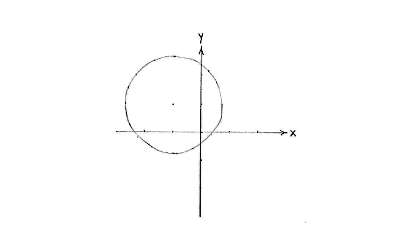Lösung 4.1:7a
Aus Online Mathematik Brückenkurs 1
(Unterschied zwischen Versionen)
K (hat „Solution 4.1:7a“ nach „Lösung 4.1:7a“ verschoben: Robot: moved page) |
|||
| Zeile 1: | Zeile 1: | ||
| - | + | In dieser Form ist es schwierig den Mittelpunkt und Radius des Kreises abzulesen. Daher benuzen wir quadratische Ergänzung um die Gleichung auf die Standardform | |
{{Abgesetzte Formel||<math>(x-a)^2 + (y-b)^2 = r^2\,,</math>}} | {{Abgesetzte Formel||<math>(x-a)^2 + (y-b)^2 = r^2\,,</math>}} | ||
| - | + | zu bringen, wo wir den Mittelpunkt und Radius ablesen können. | |
| - | + | Wir verwenden uns von quadratischer Ergänzung für jeweils die ''x''- und ''y''-Terme, und erhalten | |
{{Abgesetzte Formel||<math>\begin{align} | {{Abgesetzte Formel||<math>\begin{align} | ||
| Zeile 12: | Zeile 12: | ||
\end{align}</math>}} | \end{align}</math>}} | ||
| - | + | Also ist die Gleichung | |
{{Abgesetzte Formel||<math>(x+1)^2 - 1^2 + (y-1)^2 - 1^2 = 1\,,</math>}} | {{Abgesetzte Formel||<math>(x+1)^2 - 1^2 + (y-1)^2 - 1^2 = 1\,,</math>}} | ||
| - | + | oder auch | |
{{Abgesetzte Formel||<math>(x+1)^2 + (y-1)^2 = 3\,\textrm{.}</math>}} | {{Abgesetzte Formel||<math>(x+1)^2 + (y-1)^2 = 3\,\textrm{.}</math>}} | ||
| - | + | Dies ist die Gleichung eines Kreises mit dem Mittelpunkt (-1,1) und dem Radius <math>\sqrt{3}\,</math>. | |
<center> [[Image:4_1_7a-2(2).gif]] </center> | <center> [[Image:4_1_7a-2(2).gif]] </center> | ||
Version vom 18:15, 2. Apr. 2009
In dieser Form ist es schwierig den Mittelpunkt und Radius des Kreises abzulesen. Daher benuzen wir quadratische Ergänzung um die Gleichung auf die Standardform
| \displaystyle (x-a)^2 + (y-b)^2 = r^2\,, |
zu bringen, wo wir den Mittelpunkt und Radius ablesen können.
Wir verwenden uns von quadratischer Ergänzung für jeweils die x- und y-Terme, und erhalten
| \displaystyle \begin{align}
x^2 + 2x &= (x+1)^2-1^2\,,\\[5pt] y^2 - 2y &= (y-1)^2-1^2\,, \end{align} |
Also ist die Gleichung
| \displaystyle (x+1)^2 - 1^2 + (y-1)^2 - 1^2 = 1\,, |
oder auch
| \displaystyle (x+1)^2 + (y-1)^2 = 3\,\textrm{.} |
Dies ist die Gleichung eines Kreises mit dem Mittelpunkt (-1,1) und dem Radius \displaystyle \sqrt{3}\,.

